| Article ID | Journal | Published Year | Pages | File Type |
|---|---|---|---|---|
| 1784263 | Infrared Physics & Technology | 2014 | 6 Pages |
•GaAs1−xBix band structures have been calculated using Valence-BAC models.•Reduction of Eg by 81 meV/%Bi accompanied by an increase of Δso+ by 56 meV/%Bi.•A crossover at 0.73 eV has occurred between Eg and Δso+ for GaAs.88Bi.12.•Bismuth composition dependence on effective mass was discussed.•Intrinsic carrier density increases with both Bi composition and temperature.
The (12 × 12) and (14 × 14) valence band anticrossing (V-BAC) models were applied to calculate the electronic band structure of GaAs1−xBix dilute alloys along Δ-, Λ- and Σ-directions at room temperature. A comparative study based on these models was performed in terms of energy levels, optical transitions, spin–orbit splitting and effective mass. We found a significant reduction of the band-gap energy Eg by roughly 81 meV/%Bi accompanied by an increase in the spin–orbit splitting Δso+ by about 56 meV/%Bi. Furthermore, Δso+ does come into resonance with Eg at ∼12%Bi for resonance energy equal to 0.73 eV. An excellent agreement has occurred between the (14 × 14) V-BAC model predictions and experimental results reported in the literature. In addition, we have investigated the Bi composition and k-directions dependence of the effective mass at Γ point. A slight increase of the holes effective mass with x can affect the holes transport properties of GaAsBi. The intrinsic carrier density increases with both x and the temperature T, but it remains below 1010 cm−3 for x ⩽ 5% and T ⩽ 300 K.
